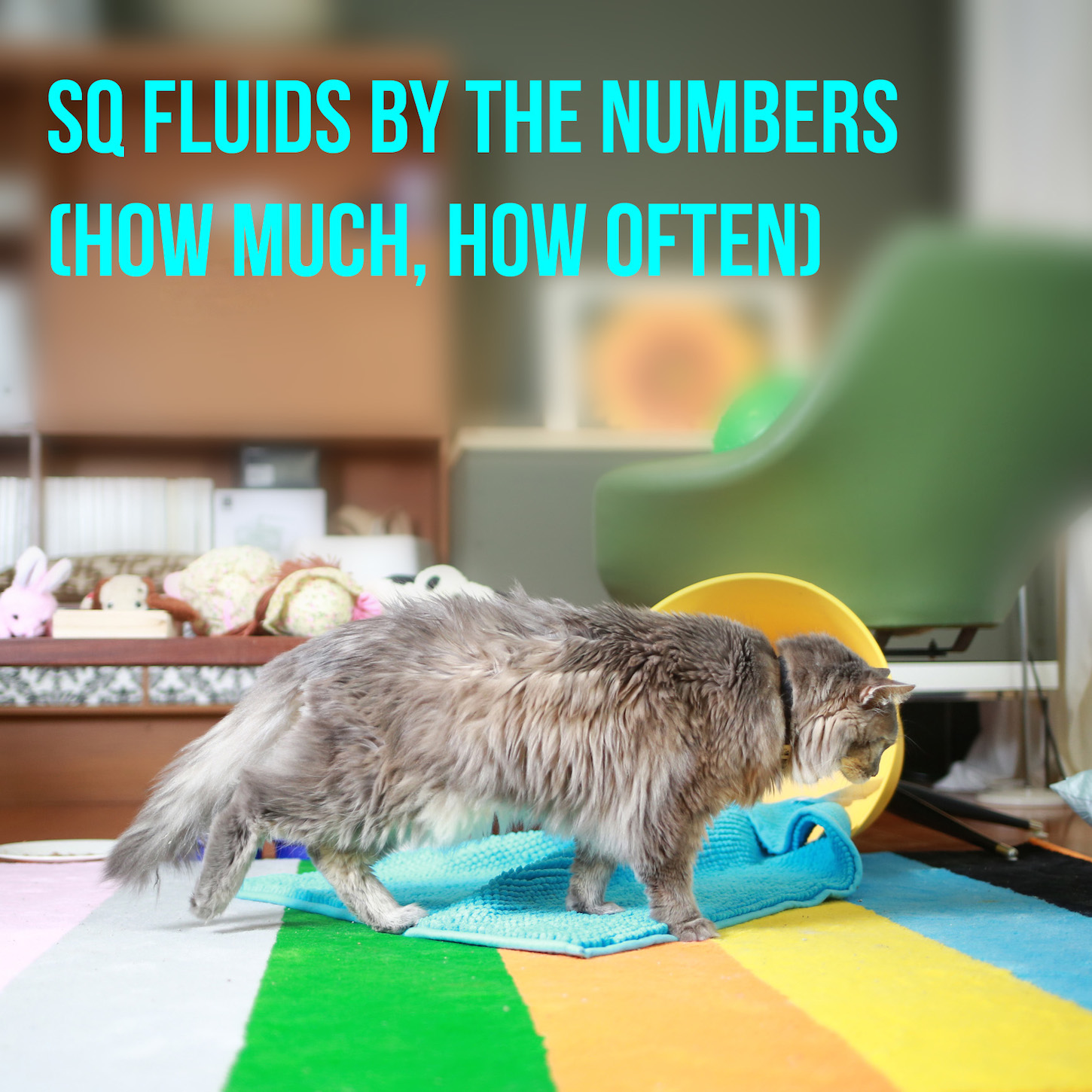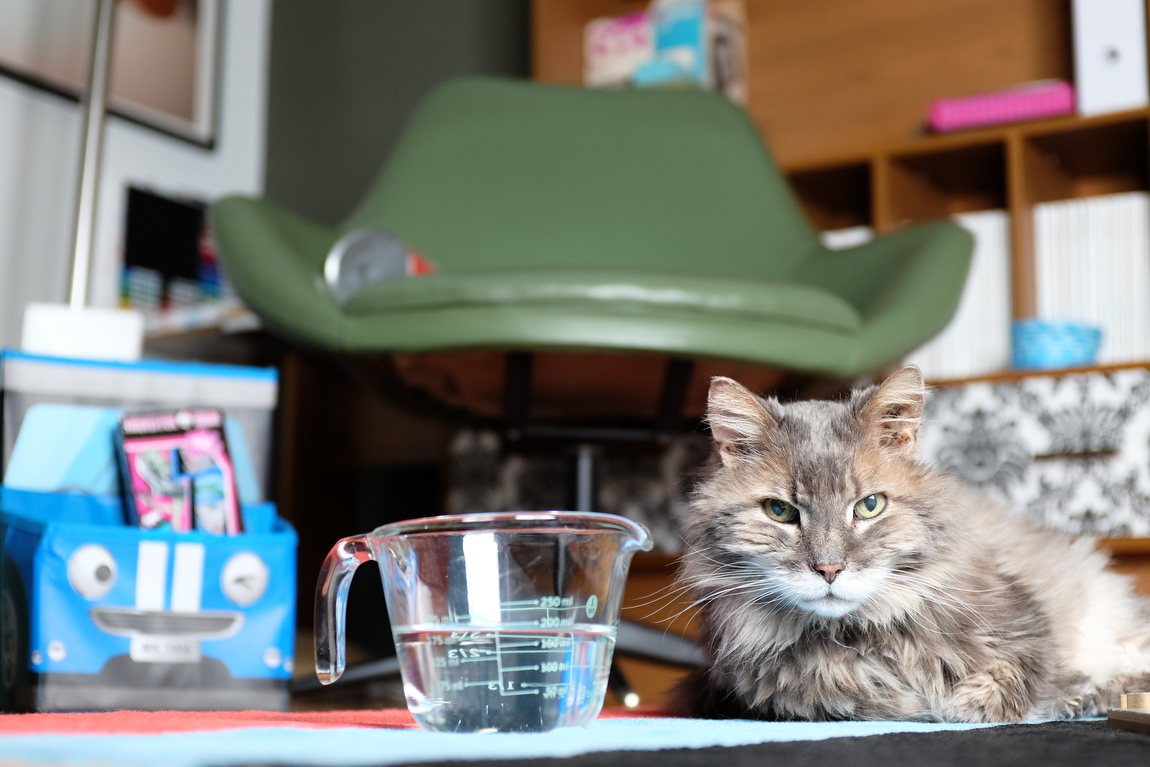
I went over some of the WHY and HOW of giving SQ fluids in my previous video. A lot of people wrote in after watching it - they were really good at giving fluids, but as time went on, the quantity or frequency that they were giving didn't seem intuitive to them. It’s your vets job to help you figure this out, but you will feel much more in control when you have a fundamental sense of where these numbers might come from. Some were reading online about the “dangers of over hydration”, and of course were concerned and wanted to know how to avoid this. This is virtually a non-issue for my patients. I noticed that no one was publishing standardized, by the numbers advice to address these sort of concerns.
Here is how I do it for my patients (click to enlarge then right click 'save as'):
SQ fluids by the numbers is a guide that you can use together with your vet to develop a fluid plan. When you have this sort of strategy, you can be in a position of getting all the benefits of using fluids accurately. The process will become even more intuitive for you. It’s all in the techniques and safety factors that are put in to place before a needle ever touches the body. Your own vets mileage may vary, so, as per anything you ever read online, you need to run this by your vet first.
See those numbers within circles on the flowchart? Those correspond to the commentary I’ve written below. You don’t need the commentary to use the chart, but it’s here if you want more info. Any questions? Leave them in the comments below!
Commentary:
Box 1) First, the safety factors. I know a lot about the cats I see before giving them ongoing prescriptions of SQ fluids to be given at home. I’ve done a physical exam at minimum and I’ve determined that there are no reasons NOT to give them fluids. In about 85% of patients that I see, I have immediate, if not recent X-rays, bloodwork and urinalysis tests done. I know the size of their heart. In some cats, I also have pro BNP info (a test that tells you if there is an increased chance of severe heart disease you don't know about - cats are great at hiding this). Sometimes I will have ultrasound information for cats with newly observed heart murmurs. All of these things I’ll recommend for not just the obviously sick cats, but also for STABLE, health looking patients. I want baseline values. I want to see how things change over time. I want all this info because the less guess work we have to do, the faster and more effective we can treat them now and over time. I want to see these guys living decades!
“What all of this means is that I have an informed idea of what issues they are facing, what their fluid requirements are, and if there are any reasons why they should not get fluids at home unsupervised.”
You can of course still give fluids to a dehydrated pet without all of the testing. I’ve worked in places where testing was NEVER going to happen because of the local economic situation. That is totally ok because we can support those people in different ways. Some folks can afford it but “don’t want that fancy medicine” (as they drive away in their BMW). Others get angry at the cost and will accuse you of x, y and z for suggesting it. Others will get upset if you DON’T suggest all of the above and will take you to task. You often will be interacting with all of these viewpoints and personality types within a single day. Such is the life of a vet - it’s a box of chocolates, and you never know who is going to walk in the door. But for those who are concerned about doing this over years without issue, those are the basic safety factors to choose from to put into the “healthy cat recipe”. Pick and choose what makes sense for you, your cat, your vet, your philosophy and your wallet.
Box 2) Get the scale. You need to have an accurate scale. Something that measures accurately to their body size, so picking them up, standing on your scale and subtracting your weight isn't good enough. Weight indirectly informs you of frequency and quantity of fluids, and a myriad of other health factors. Without having accurate body weight info, you are flying blind. There is not a single time in the last 10 years I’ve given or prescribed fluids to a cat without knowing its weight. Your cats should get better BECAUSE of us, and not IN SPITE of us! This and the commentary #1 above is probably why I’ve never, once, run into over-hydration issues. Not. Once.
Box 3) No dead horse beating here, but whenever you read stuff online, check with a vet you trust first. Even if your vet isn't up to speed with a particular technique, methodology or medication (we tend to have our special interests that we are probably most up to date with), they have the benefit of seeing thousands of pets. This kind of experience is great for predicting potential success or problems.
Box 4, 6, 8) When I was doing graduate research at the University of Guelph, we used animal behaviour, combined with information about neuroanatomy and stress to figure out how an animal might feel about any particular situation. Without being able to directly measure the thing we were after, we could correlate things we knew to become accurate about something we wanted to know. This is the entire, underlying foundation of fields such as animal cognition and emotion.
This fluid chart is based on the same principle. You are using knowledge of their behaviour and stresses they face to derive their internal fluid needs. At 1, 2, or 3% BW, cats do not necessarily physically show signs of dehydration. Yes, one could try and figure it out it by monitoring how much moisture is in their poop, assessing gum consistency, skin turgor, urine volume, blood pressure and micro changes in body weight and so on. How much equipment do you have at home? How much time do you have in a day? It’s a hard way that leads to about the same numbers.
The reality is that for most cats, you are simply supplementing their fluid intake or making it easier for them to deal with losses. Above and beyond the water that we all lose every day just by living life (your maintenance amount, which is discussed below), any of the following will increase how much fluids you need: eating less food than you should, kidney issues, vomiting or diarrhea, pancreatitis, liver issues, infection, inflammatory bowel conditions, anything causing them to drink or pee too much (e.g. hyperthyriodism, diabetes, hypercalcemia), and medications that could cause toxic issues if they became dehydrated while taking them. Notice that 1, 2 and 3% BW fluids are always below their daily maintenance amount. This is an additional safety factor placed into this system. These values are derived from estimates of what is known as “sensible and insensible” losses. It’s boring so I wont write about that any further…
Box 10, 11 and 12)
You lose a lot of water every day just by living life. This is why you hear that humans can live a long time with fasting, but not very long without drinking. Your cat will pee, poop, salivate and evaporate water all day long. The basic, daily amount to just live life is called your maintenance rate.
So a 5kg cat loses, on average 9ml each and every hour just by living his life. If I have a cat, who has eaten nothing, drunk nothing and is doing nothing all day, I already know 220ml of fluid is missing from his body within 24 hours.
About a quarter of a litre. Does it seem like a lot? It is. And this is the most typical observable amount of dehydration I see in practise. 220ml is what this particular cat needs, at minimum to optimally support life, within a 24 hour time period. That is his maintenance rate. There is no worry giving him that quantity of fluids in this scenario, because he would voluntarily give himself that amount of fluids within one day by instinct to keep living (via eating or drinking). If any cat did not look well after receiving his or her calculated basic maintenance amount, it is because there is another disease process happening in the body. That is ALWAYS your first assumption. Mess up that assumption and you will miss concurrent problems in the majority of your patients.
Box 13) Cats will naturally replenish the water they need over the course of a day via grazing wet food or drinking water. In a clinical setting, cats on IV get their maintenance amounts, or multiples of that amount, over the course of 24 to 36 hours. Should you try and duplicate this at home? Giving very small amounts multiple times a day? The reality is, that as a vet, when we make these sort of recommendations, we also have the unintended effect of increased rates of euthanasia. It’s true. How we design treatment plans for our patients not only influences the rates of success, but also the rates of premature euthanasia if you have overwhelmed someone and they can’t see the light at the end of the tunnel. My own personal rule is that if the TOTAL amount is less than 5% of their body weight in a pre-screened cat, you can give it SQ all at once. Why is this my own personal rule? Because I have had no issues working within this guideline amongst thousands of cats, prescreened with all the safety factors as discussed above. If you would like to give half in the am, half in the pm, then great, it’s a nice thing to do.
PS 1 - A note about “How often to give”: It’s an art and a science. Most things in veterinary medicine are like this. As it turns out, there is a relationship that the more fluids they need in terms of % BW, there is a good chance that they need it more frequently as well. I’m sure someone out there could do a retrospective analysis and generate a linear regression. If they are losing body weight, they often have conditions that steal hydration or make it harder to hydrate themselves. If they are stable with their body weight, that might correlate with a pet who can maintain themselves with less supplementation. See how that is already worked out in the chart? See how accurate body weight is hugely important in assessing a variety of things?
PS 2 - Why would some cats have problems with fluid therapy? Or be at risk of over-hydration? The reality is that some cats are ALREADY in a state of fluid overload internally, yet visibly can look dehydrated! This isn't your everyday cat. This is a special case scenario. Most of the time, this is really about about cats who are within a state of sodium overload - by way of their heart or pulmonary illness, severe liver disease (cirrhosis) or hyperaldosteronism. Either pre-existing or developed over time. It’s about messing up a cat’s extracellular space (ECF) even further by dumping sodium in there via more sodium containing fluids.
I’ve noticed online that this scenario is combined or confounded with so much other data showing risks from IV recitation of hypothermic cats, or relating SQ fluids directly with the mechanical development of pleural effusion (i.e. it’s “squishing into the lungs”). I’m not saying there is no merit to those view points to educate towards precautions. But I am saying they have to be balanced out. I see cats every single month with fluid retention or pleural effusion. How many of those are cats are regularly receiving prescribed SQ fluids? Zilch. Zero. Nadda. Not even close to a daily, weekly or monthly correlation. Fluid retention ending up in the lungs from properly administered SQ fluids is not the norm. Dehydrated cats ARE the norm. Yes, fluid retention can happen as can any rare adverse reaction. But treat enough cats afflicted with cryptococcus (a brutal, life threatening fungal infection) with Amphotericin B, which is delivered by larger than maintenance doses of dextrose containing SQ fluids frequently, and you quickly learn that it isn't the volume that you worry about in pre-screened cats. It’s the sodium. I’m not saying don't be cautious or discriminating with anything that you put into your pet. I’m saying get informed so fear and insecurity is not the basis for altering your treatment plan. As always, veto any information you find online with your vet. Use their experience to bounce these opinions off of.
k




